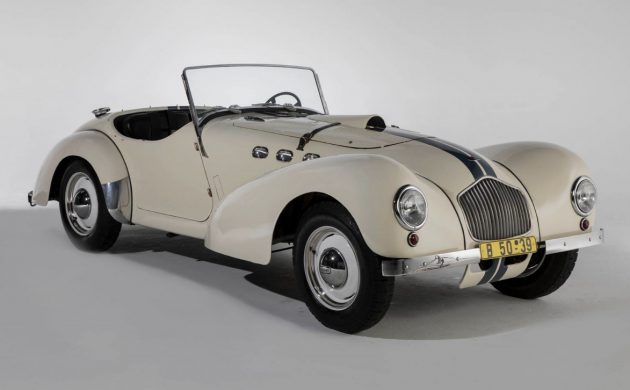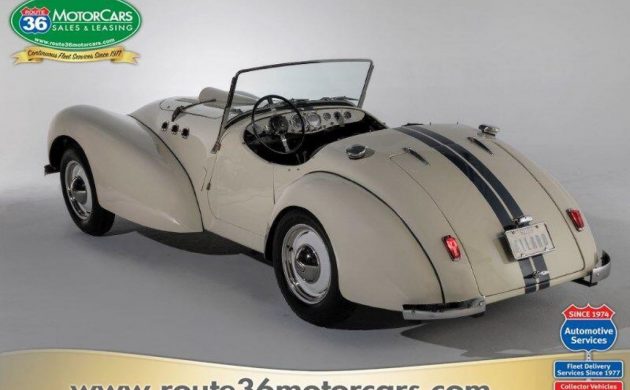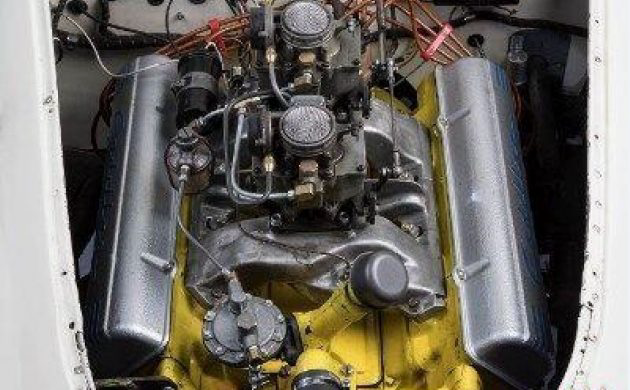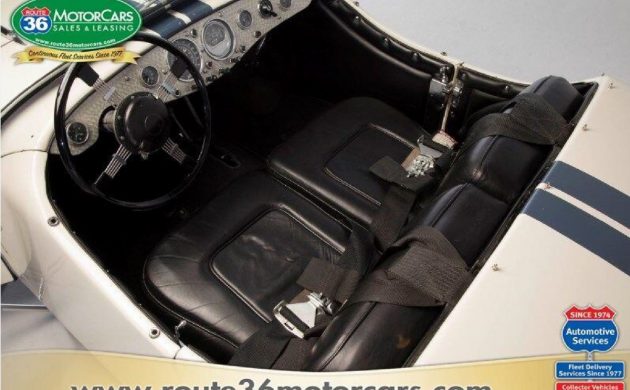1-Of-79: 1952 Allard K2 “Cad-Allard”
The pages of automotive history books are littered with the names of British sports car manufacturers who are, sadly, no longer with us. One of the true greats was Allard. While it might not be the most instantly recognizable brand, there is a chance that it played a significant part in American automotive history. The company collapsed in 1958 after only producing cars for 12-years. This particular vehicle is a 1952 Allard K2, and it is 1-of-79 built in left-hand-drive form. It has undergone a meticulous refurbishment and is now in search of a new home. If you’ve got a healthy wallet and a passion for British classics, then you will find the Allard located in Dublin, Ohio, and listed for sale here on Facebook. Hand the owner $107,975, and you can drive this magnificent classic home.
The Allard was created using a recipe that will sound all too familiar to American performance car enthusiasts. The company made a lightweight sports car, and once they were shipped to the US, V8 engines were fitted under the hood. Notable individuals who drove or raced these cars during the early 1950s included Zora Arkus-Duntov and Carroll Shelby. You have to wonder whether this experience prompted these two automotive greats to consider the potential available in a lightweight sports car powered by a potent V8. It does seem like a bit more than a mere coincidence to me. The K2 was introduced in 1950 and was an evolution of the previous K1 model. It remained in production through to 1952, and in this time, 119 cars were built. Draped over the steel frame is an exquisite handbuilt aluminum body with hints of classic Jaguars in its styling. The three vents on either side of the hood are reminiscent of Buick Ventiports and add a further air of style and sophistication. When it arrived in America, this Allard saw use until 1957. It then sat neglected behind a commercial building until it was “discovered” in 1982. It was refurbished, with this work being completed in 1996. It is finished in Ivory with Blue stripes, and every aspect of the car presents beautifully. The paint is flawless, the panels maintain their stunning curves, and the vehicle’s underside is spotlessly clean. I do have to question whether the hood scoop is original. I have seen examples of the K2 with a bulge but not a scoop. Of course, the handbuilt nature of the Allard could mean that it is either original or was fitted in this car’s early days in the USA. The trim and chrome are perfect, while the same is true of the wheels, trim rings, hubcaps, and glass.
While 79 of these classics made their way to the US, the remaining 40 cars remained in Britain. For the domestic market, Allard slotted Ford and Mercury V8s under the hood. The vehicles that were destined for export left the factory minus an engine. Once they arrived in America, engines from Chrysler or Cadillac were installed. However, this was not a hard-and-fast rule because some American cars did feature a Ford V8. Under the hood of this car is a Cadillac V8, but it is far from your average engine. I’ve done some research on this particular car and have managed to dig up some interesting history. The engine block is unstamped, but it did start its life as a 331ci motor. It was handed to Vic Edelbrock Sr, who went to work waving his magic wand over it. The capacity was increased to 400ci using a bore of 4″ with a matching stroke. It isn’t clear what other secrets were hidden away during the original build, but after sitting for decades, the engine was sorely in need of some TLC. It received this between 2016 and 2018. It was stripped and rebuilt using JE pistons and an Isky camshaft. Sitting atop the V8 is a Detroit Racing Equipment intake and a pair of Carter 4-barrel carburetors. Since the rebuild, the engine has done only break-in time on a lift, and the car has been driven on and off a trailer. However, it is said to start immediately, and it runs perfectly. Backing the 400 is a 3-speed LaSalle manual transmission, which sends the power to the rear wheels. It isn’t clear what sort of power this engine produces, but a regular 331-equipped K2 had 160hp to play with. This meant that it was capable of covering the ¼ mile in 15.6 seconds. I suspect that this Allard would blow that figure into the weeds.
While it is tempting to refer to this Allard as a restored classic, I have avoided that phrase up to this point. There is a fair hole in this car’s history, and it isn’t clear whether it actually saw competition use during its early days. There is a reasonable chance that it did, but that is by no means certain. During its revival, the K2 has been fitted with a secondary fuel tank, along with a set of racing harnesses. The interior of this car needs little because it does present beautifully. The leather upholstery and the carpet are perfect, it is fitted with the right steering wheel, and the machine-turned dash is gorgeous. However, there are a few changes that are worth noting. The dash features the correct Allard speedometer. The rest of the gauges are a mixture. There is a Sun electronic tachometer, with the remaining gauges being Stewart Warner items. It is these sorts of details that have motivated to refer to this classic as refurbished.
At the end of the day, there is no arguing about the rarity of this Allard K2. Because these are a handbuilt sports car, it allowed the company to personalize the build and specifications for individual buyers. That means that it is possible that it was sold to an owner intent on competition work, which would explain the engine upgrades and the hood scoop. This is something that we may never know for sure. The rarity means that these are not a car that will come onto the market that often. This one was previously offered for auction on another site, and it failed to sell when bidding closed at $82,500. Tracing back through past sales results indicates that the asking price in this listing would be close to the mark, especially given the vehicle’s overall condition. However, it has been on the market for a while now, so maybe a sensible offer would be considered. You never know because it costs nothing to ask the question. The worst that the owner can say is no.
Auctions Ending Soon
 1971 Ford Mustang Mach 1Bid Now9 hours$7,100
1971 Ford Mustang Mach 1Bid Now9 hours$7,100
 2003 Porsche Boxster SBid Now10 hours$6,250
2003 Porsche Boxster SBid Now10 hours$6,250
 1966 Lincoln ContinentalBid Now12 hours$500
1966 Lincoln ContinentalBid Now12 hours$500
 2000 Jaguar XJ8LBid Now4 days$1,250
2000 Jaguar XJ8LBid Now4 days$1,250
 1977 Datsun 280ZBid Now5 days$275
1977 Datsun 280ZBid Now5 days$275






Comments
Fantastic cars, but I’d pull that Caddy motor and replace it with a Chevy V-6,,,,you see how silly that is? Seriously, the Allard, I believe, beat them all to the V8 2 seat sports car. Whoever bought an Allard in 1952, had the hottest stick out there. Leave it to the Brits!!
So I’m gonna spend over 100K on this, and you can’t even put a nice set of wheels on it? It’s an attractive car but PASS!
With all due respect, Skorzeny. If you can afford $108K, you can afford to put on your own wheels.
If you want an Allard, I know where there is a building full of unrestored ones. No kidding! The guy knows what he has, but is motivated to clear them out.
Note that the 1954 Nash Ambassador Country Club Lemans is as rare as an Allard J2. And has a roof.
LOVE these. That writeup reminds me of an acquaintance, though . . . Lots of stories and name dropping, without much (in this case, papers) to back it up. Vic Sr. modified engine? Not every car that got an Edelbrock intake was Vic Sr. modified . . .
Allards were built using a modified Ford Pilot chassis and 30HP sv V8.Later cars,from 1951,had an OHV engine.In 1955,Cadillac and Jaguar engines were used.I recall being offered a rough K1 for £500 in 1977 – turned it down!
Text indicated the engine has twin 4 barrel carbs. Looks like a pair of 2 barrel carbs to me.
Look again, very carefully.
John,
I did look again, what I see is a pair of Carter WCD 2 barrel carbs, as commonly found on 1951 & back Cadillacs [single carb only], and early to mid 50s smaller GM cars like 6 cylinder Pontiacs & Oldsmobiles, as well as Nash 6 engines.
As the car is a 1952 Cadillac, the correct single carb would be a Carter WCFB 4 barrel as found on 1952-1954 Cadillac, Buick, Oldsmobile 8, and senior Packards.
!952 was the first model year the Carter and the Rochester 4-barrel carbs were available. The carbs pictured are not the Carter WCFB or the Rochester 4-jet, the only 4-barrel carbs available at the time.
I spent 35 years restoring these cars and their carbs, and I’m sure of the above info. As I’m not a paying member I can’t post a photo of the WCD in my parts inventory, for comparison [it matches what is on the Allard engine].
This is quintessential English sports roadster.
If I had an extra $108K, I would go for it.
I can just see myself, cruising down the highway with the top down, letting the breeze flow through my, what once was, my hair. LOL!!
There is a great story in Automobile Quarterly about a girl taking her father’s Allard to school. She blows off the high school hero in a race. He was famous for his car’s ability to lay 37.5 ft of rubber. The line went something like … while he was burning 37.5 feet of rubber she disappeared over the hill, While something like that; it was long ago. My friend Larry liked that story so much his nick name became 37 and a half foot Lar. If you can find it it’s worth a read.